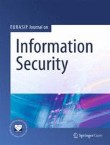Fingerprint-based crypto-biometric system for network security
To ensure the secure transmission of data, cryptography is treated as the most effective solution. Cryptographic key is an important entity in this process. In general, randomly generated cryptographic key (of...
